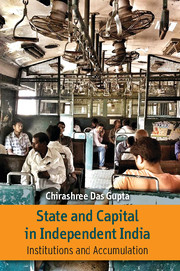Book contents
- Frontmatter
- Dedication
- Contents
- Figures
- Tables
- Acknowledgements
- 1 Introduction
- 2 Globalization and Neoliberalism: The Context and the Debate
- 3 State and Capital in Independent India: The Problematic
- 4 Policy Regimes and Macroeconomic Outcomes: 1947–1966
- 5 Institutionalization of the Regime of Capital in India: 1947–1966
- 6 Continuity and Change in Capital Accumulation: 1966–1980
- 7 Sources of Accumulation: State Intervention and Non-intervention
- 8 ‘Old Oligopolies and New Entrants’ in the Pharmaceutical Sector
- 9 Conclusion
- Bibliography
- Index
7 - Sources of Accumulation: State Intervention and Non-intervention
Published online by Cambridge University Press: 05 September 2016
- Frontmatter
- Dedication
- Contents
- Figures
- Tables
- Acknowledgements
- 1 Introduction
- 2 Globalization and Neoliberalism: The Context and the Debate
- 3 State and Capital in Independent India: The Problematic
- 4 Policy Regimes and Macroeconomic Outcomes: 1947–1966
- 5 Institutionalization of the Regime of Capital in India: 1947–1966
- 6 Continuity and Change in Capital Accumulation: 1966–1980
- 7 Sources of Accumulation: State Intervention and Non-intervention
- 8 ‘Old Oligopolies and New Entrants’ in the Pharmaceutical Sector
- 9 Conclusion
- Bibliography
- Index
Summary
This chapter is a survey of the role of both state intervention and non-intervention in the accumulation process that came into being after the crisis of 1965–66. The period from 1965 to the 1980s for the capitalist class in India was one of negotiating its complementary relationship with the state in the face of its own growth and diversification with the rise of ‘new’ capitalists in various parts of India. In this chapter, we identify some of the processes of accumulation through which these new groups of proto-capitalists emerged through the mid 1960s and the 1970s. However, it is important to note here that the pressure to turn away from the old style of dirigisme in India came from a number of different, but related, directions. One was from new aspirants to the capitalist class, who saw the abuses of the licensing system by the clique of ‘insider’ capitalists in the 1970s as a threat. Congress appeared not to be able to guarantee that the licensing system would assist the primary accumulation of new aspirants as it had assisted the first generation of capitalists. This was separate from the other principal constituents of society, which were also rising in discontent against the state in the mass strikes of 1974, the petty-bourgeois discontent in Bihar and Gujarat and the movement for land reform led by the Left. Ironically, this discontent, often directed against inequities in terms of asset concentration in the hands of ‘big’ capitalists and landlords led to responses from the state that in terms of policy facilitated a process of expansion by the capitalist class as ‘new’ capitalists set up business groups in various parts of India. The process of this expansion is the subject of this chapter.
Economic policy in this period was a mix of interventions and non-interventions or even withdrawal. So what constituted state autonomy is difficult to isolate at this level by use of a false dichotomy between the public and private sectors, as is often presented in neoclassical analysis of this period for example in the writings of Bhagwati (1998). To understand the political dynamics of this period of increasing or decreasing relative autonomy, one has to take into account two broad factors – first, the social processes of accumulation both in the industrial and other sectors of the economy, and second, the domains of state intervention.
- Type
- Chapter
- Information
- State and Capital in Independent IndiaInstitutions and Accumulations, pp. 177 - 217Publisher: Cambridge University PressPrint publication year: 2016



